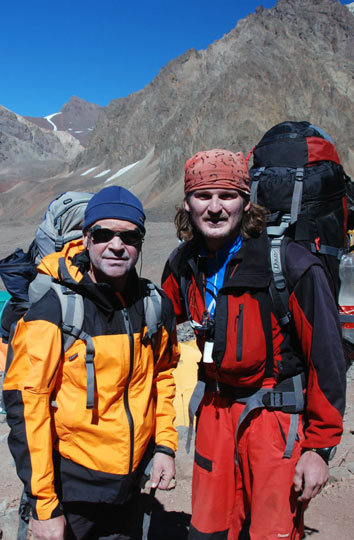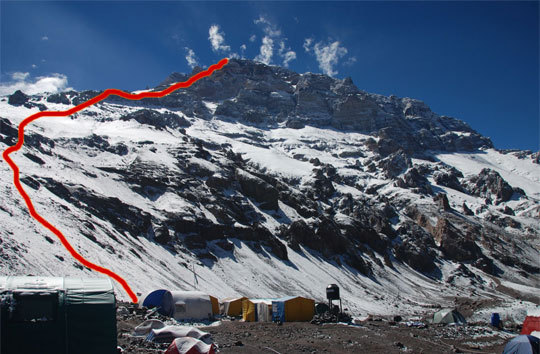
The west face of Aconcagua (6962m), Argentina, South America’s highest peak. The pair intended to climb a new route on the mountain’s south face, but judged the conditions too dangerous. The Czech Route is the third new route on the mountain in the last twenty years. [Photo] Courtesty of Leopold Sulovsky
Czech climbers Leopold Sulovsky and Josef Lukas climbed a new route on the west face of Aconcagua, Argentina, in alpine style, summitting on January 30, 2008. The 6962-meter peak is the highest mountain in the Americas, the highest mountain outside of Asia, and is one of the Seven Summits. The pair had planned on climbing Aconcagua via its south face, but ultimately decided on the west face due to better snow conditions. Sulovsky, 53, said in a report that the climbing was difficult and they encountered harsher conditions–including 40 degrees below zero temperatures–than he had during his successful ascent of K2’s Cesen Pillar in 2007. Sulovsky was the first Czech to climb Mt. Everest, summiting in 1991 via the north face’s Norton Couloir route. Lukas is known for many expeditions to the greater ranges, as well as a 2007 K2 ski descent from 6200m to basecamp.

Sulovsky, left, was the first Czech to climb Mt. Everest, summiting in 1991 via the north face’s Norton Couloir route. Lukas, right, is known for many expeditions to the greater ranges, as well as a 2007 K2 ski descent from 6200m to basecamp.
The new route ascends the west face to climber’s left of the existing West Face Route, crossing that route high on the face then skirting to the right of the Gran Acarreo—a prominent scree slope. The beginning pitches comprised mostly snow climbing, but as the route steepened, multiple rock steps were encountered. The pair spent three days on the ascent, bivying at 5300m the first night and 6300m the next. Despite fog and questionable visibility, a third day of climbing brought them to the summit in the early evening. The pair then descended to 4800m, bivied, and returned to basecamp the following day.
Though the pair packed minimally, their packs remained fairly heavy (25-27kg) because of the extra gear needed to contend with the brutal cold and strong winds. Despite multiple pairs of gloves and “perfect boots”, both reported some minor frostbite on all extremities.
Though the technical difficulties of the climb were not horrendously difficult by modern standards (UIAA 4-5), it was made significantly more interesting by very unstable rock, including huge, shifting blocks and almost constant bombardment by debris.
The new route, still unnamed as of press time, is only the third reported on the peak since 1988’s Sun Line Route (ED1: 5.10+ 90 degrees, ca. 2400m, Romih-Sveticic) and 2003’s Mobitel Swallow-Johan’s Route (VI 5.10 A2 100 degrees M6, ca. 2500m, Humar-Kozelj).

Josef Lukas climbing through one of the innumerable unstable rock bands. The team simul-soloed much of the route. [Photo] Leopold Sulovsky

A foreshortened view of the new Czech Route on the west face of Aconcagua. [Photo] Courtesy Leopold Sulovsky